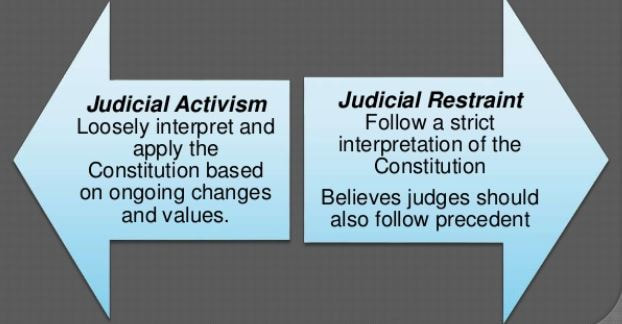JUDICIAL ACTIVISM: Here, the judiciary exercises its power to implement and enforce the constitutionally correct laws which are beneficial for the society at large and exercises its power to strike down the laws or rules which infringes the basic rights of the citizens.
JUDICIAL RESTRAINT: This asserts that judges should hesitate to strike down laws unless they are obviously unconstitutional. Judicially-restrained judges respect stare-decisis, the principle of upholding established precedent handed down by past judges.

The difference between judicial activism (“loose constructionist”) and “judicial restraint (“strict constructionist”). These are ways of interpreting the Constitution. A judge who is a strict constructionist might rule in cases in a way that reads the Constitution very literally or relies on the original intent of the framers. A judge that is a judicial activist might rule in a very broad manner that takes into account how times have changed.
Judicial Activism and Judicial Restraint are two opposite approaches. Judicial activism and judicial restraint, which are very relevant in the United States, are related to the judicial system of a country, and they are a check against the fraudulent use of powers of the government or any constitutional body.
1. Judicial activism is the interpretation of the constitution to advocate contemporary values and conditions.
On the other hand, judicial restraint is limiting the powers of the judges to strike down a law.
2. In the matter of judicial activism, the judges are required to use their power to correct any injustice especially when the other constitutional bodies are not acting.
This means that Judicial activism has a great role in formulating social policies on issues like protection of rights of an individual, civil rights, public morality, and political unfairness unlike judicial restraint.
3. Judicial restraint helps in preserving a balance among the three branches of government, judiciary, executive, and legislative. In this case, the judges and the court encourage reviewing an existing law rather than modifying the existing law.
Judicial activism gives the power to overrule certain acts or judgments. For example, the Supreme Court or an appellate court can reverse some previous decisions if they were faulty. This judicial system also acts as checks and balances and prevents the three branches of government, judiciary, executive and legislative from becoming powerful.
4. Judicial activism is the interpretation of the constitution to advocate contemporary values and conditions.
Judicial restraint is limiting the powers of the judges to strike down a law. In judicial restraint, the court should uphold all acts of the legislature unless they are violating the constitution of the country.
5. Judicial Restraint involves looking at the original intent of the writers of the Constitution.
Judicial activism involves looking beyond the original intent of the framers (after all they were mere humans too and not infallible to making mistakes).
TO SUMMARIZE THE ABOVE,
| JUDICIAL ACTIVISM | JUDICIAL RESTRAINT |
| Look beyond the original intent of the Framers | Look to the original Intent of the Constitution |
| “Living Constitution” (changes over time) | Look at the Intent of legislators that wrote the law |
| Active Action is necessary and appropriate at times | Respectful of Precedents |
| Can be involved in interpreting and enlarging laws | Argues that changes to the Constitution can be made only through the Amendment process. |
Read our article to know more about the practical scenario in relation to Judicial Activism and Judicial Restraint













